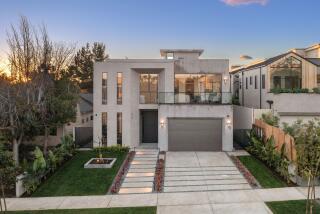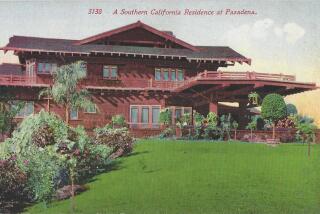‘Good’ Design Ideals Questioned
“Recognizing the Basics of Good Design” (by Lew Sichelman, Real Estate, Sept. 21) insults the intelligence of all architects and home buyers. The article is directed to some mythical Joe Average home buyer. This average American does not exist except in statistical reports.
The principles stated were in no sense universal but were always specific to the needs of Joe Average. For example, dramatic bedrooms and king beds are not essential elements of all home buyers’ lives. (Who are these guys trying to impress anyhow?) Great natural lighting with sufficient space for a bed will be a satisfactory compromise for some.
Most insulting, however, is commentary on the foyer. Perhaps the most dramatic entry in all of American residential architecture can be found in Frank Lloyd Wright’s Fallingwater: The front door opens in a closed cave-like hallway and only after turning a corner does one see the space open into as grand a vista of the natural world as anyone could wish. The spatial contrast is the very source of beauty. Can an open sight-line work as well?
Of course, but do not insult us by pretending that it is the only “good” and ‘universal” way to design a house.
For some more practical recommendations:
* A TV nook on an exterior wall can be an eyesore when viewed from the outside, so be careful.
* Unless the buyer is enamored of electrical fans, all full bathrooms should have windows to promote air circulation and prevent mildew.
* The magpie in the family will love the walk-in closets, but the neat and orderly member may well grow to hate their storage capacity.
The article succeeds wonderfully in presenting the “arch-dictatorship” of mass developers and the architects in their pay.
HABIBOU and CAROLYN SISSOKO
Culver City
*
As a professional model home merchandiser in Southern California, I would like to state that we do not trick buyers by using under-scaled furniture (“How Does the House Fit?,” Sept 21).
This might have been true 30 years ago when the model-home industry was in its infancy, but today’s home buyers are very experienced and not so easily fooled.
A home can be made to look larger by the effective and detailed coordination of colors, finishes, accessories and the identification of focal points. It is not accomplished by using under-scaled furniture.
CHERRY L. HENRICKS
Northridge
More to Read
Sign up for Essential California
The most important California stories and recommendations in your inbox every morning.
You may occasionally receive promotional content from the Los Angeles Times.






